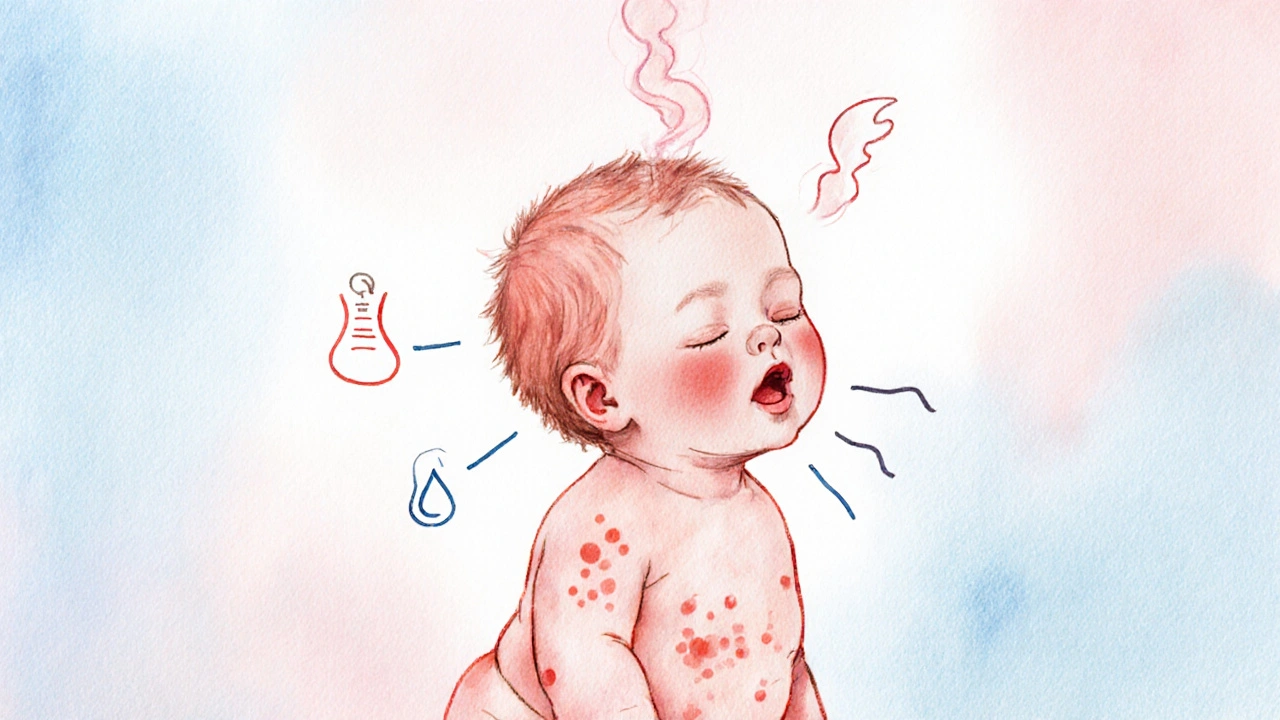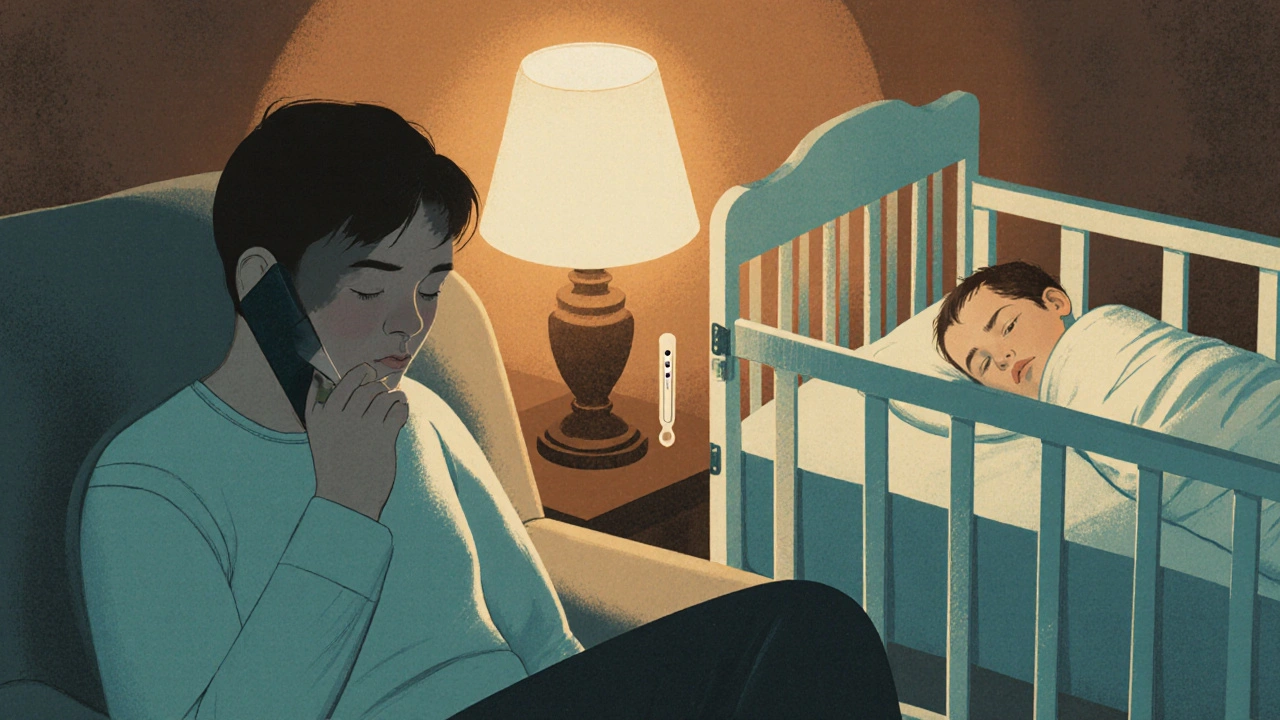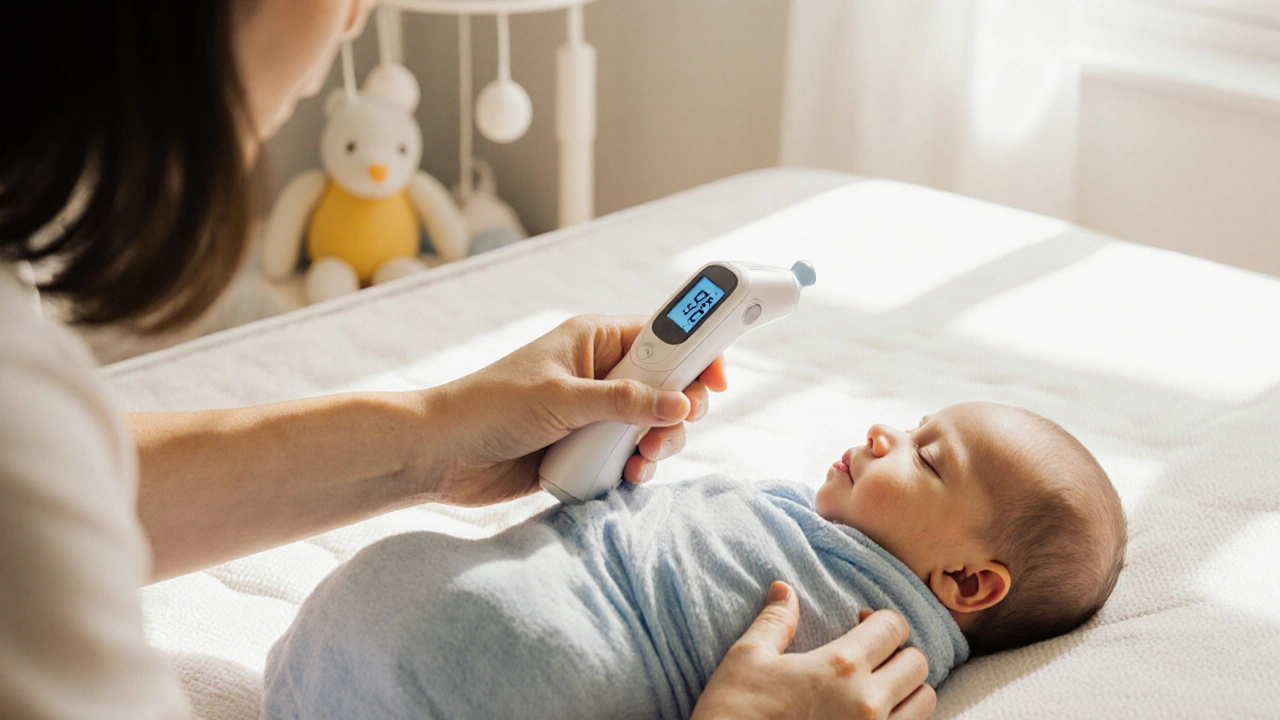Infant Fever Assessment Tool
Spotting a fever in a baby can send any parent into a panic mode. One minute your little one is cuddly and content, the next a tiny thermometer flashes a number you’ve never seen before. Knowing what that number means, when it’s safe to wait, and when a call to the pediatrician can save a lot of sleepless worry. This guide walks you through the basics of infant fever, how to measure it accurately, home care steps, and the red‑flag signs that demand professional help.
What Counts as a Fever in an Infant?
Fever in Infants is a body temperature at or above the level considered normal for babies, typically 100.4°F (38°C) when measured rectally. For newborns (up to 3 months), even a slight rise above this threshold can signal a serious infection, so the margin for error is tiny.
Temperature ranges differ by measurement site:
- Rectal: 100.4°F (38°C) or higher
- Axillary (underarm): 99°F (37.2°C) or higher
- Temporal artery (forehead): 100.4°F (38°C) or higher
- Tympanic (ear): 100.4°F (38°C) or higher
Because the rectal route most closely mirrors core body temperature, pediatricians often ask for a rectal reading for infants under 3 months.
How to Measure Temperature Correctly
Choosing the right device and technique is crucial. Here’s a quick rundown of the most common tools:
| Method | Accuracy | Best Age Range | Pros | Cons |
|---|---|---|---|---|
| Rectal thermometer | High | 0‑3months (gold standard) | Most reliable core temp | Invasive; requires lubrication |
| Axillary (under‑arm) | Moderate | All ages | Non‑invasive, easy | Can underestimate by 0.5‑1°F |
| Temporal artery scanner | High | 3months and up | Quick, no contact | Costly device; technique‑sensitive |
| Tympanic (ear) thermometer | High | 6months and up | Fast, single‑handed | Earwax or shape can affect reading |
When you’re at home, a digital rectal thermometer (or a digital stick‑on with rectal tip) is the safest bet for babies under three months. Make sure the tip is lubricated with a water‑based gel, insert it only about ½ to ¾ inch, and hold it steady until it beeps.

When to Call the Pediatrician - Red‑Flag Symptoms
Most fevers are caused by viral infections that resolve on their own, but infants can deteriorate quickly. Call your pediatrician (or go to the emergency department) if you notice any of these signs:
- Infant under 3months with a rectal temperature ≥100.4°F (38°C)
- Temperature ≥104°F (40°C) at any age
- Persistent fever lasting more than 24hours in a newborn or more than 72hours in older infants
- Difficulty breathing, rapid breathing, or wheezing
- Severe irritability or lethargy - the baby is hard to wake
- Persistent vomiting or diarrhea leading to signs of dehydration (dry mouth, no tears, fewer wet diapers)
- New rash, especially if it’s purple, blotchy, or spreading quickly
- Seizure activity - even a brief shaking episode qualifies
- Any underlying medical condition (prematurity, heart defect, immunodeficiency)
These warning signs often point to bacterial infections, meningitis, or febrile seizures-conditions that need prompt medical evaluation.
Understanding Febrile Seizures
Febrile Seizure is a convulsion triggered by a rapid rise in body temperature, typically in children between 6months and 5years. While terrifying to witness, most febrile seizures are brief (under five minutes) and don’t cause lasting brain damage.
If your baby experiences a seizure, note the following before calling:
- Duration - stop the clock as soon as the episode starts.
- Position - gently place the infant on their side to keep the airway clear.
- Do NOT put anything in the mouth.
- Call emergency services if the seizure lasts longer than 5 minutes or if breathing stops.
Afterward, a pediatrician will likely order lab tests to rule out infection and may discuss fever‑reduction strategies.
Home Care Tips While You Wait for the Doctor
Even if you’ve called the pediatrician, the following steps can keep your baby comfortable and prevent dehydration:
- Acetaminophen is a mild pain reliever and fever reducer safe for infants when dosed by weight. Use the exact syrup concentration prescribed and follow the weight‑based dosage chart.
- If your child is older than 6months, Ibuprofen is another fever‑reducer that works well for infants over 6months. Do not give ibuprofen to babies under 6months.
- Offer breast milk or formula frequently - small, regular feeds help maintain hydration.
- Dress your baby in lightweight clothing and keep the room temperature around 68‑72°F (20‑22°C). Over‑bundling can trap heat.
- Use a lukewarm sponge bath if the fever spikes above 102°F (38.9°C). Avoid cold water; it can cause shivering, which raises core temperature.
Never give aspirin to an infant, as it’s linked to Reye’s syndrome, a rare but severe liver condition.

What Information to Have Ready for the Pediatrician
When you call or arrive at the clinic, the pediatrician will ask specific details. Having these on hand speeds up assessment:
- Exact temperature reading (including measurement site and device used).
- Time fever started and any spikes.
- Feeding patterns - any refusal, vomiting, or changes in diaper output.
- Recent sick contacts, travel, or vaccinations.
- Any medications already given (type, dose, time).
- Presence of additional symptoms like cough, rash, or ear pulling.
Providing clear, concise answers helps the clinician decide whether a simple observation plan suffices or if labs/imaging are needed.
Prevention Tips to Lower Fever Risks
While you can’t eliminate all infections, a few habits reduce the chance of fever‑inducing illnesses:
- Hand‑wash frequently - especially before feeding or handling the baby.
- Keep sick family members away from the infant’s immediate environment.
- Stay up to date with the immunization schedule - vaccines protect against meningitis, pneumococcal disease, and influenza, all common fever triggers.
- Maintain a smoke‑free home; secondhand smoke raises respiratory infection risk.
Even with perfect hygiene, babies will catch bugs; knowing the warning signs ensures you act fast.
Frequently Asked Questions
How high does a fever need to be before I panic?
For infants under 3months, any rectal temperature ≥100.4°F (38°C) warrants a call to the pediatrician. For older babies, you can usually monitor at home until the fever reaches 104°F (40°C) or if other alarming symptoms appear.
Is it safe to give my 2‑month‑old baby ibuprofen?
No. Ibuprofen is only approved for infants 6months and older. For a 2‑month‑old, stick with acetaminophen at the correct weight‑based dose.
Can a fever itself cause a seizure?
A rapid rise in temperature can trigger a febrile seizure in some kids, especially between 6months and 5years. The seizure is usually brief and not harmful, but it does require medical evaluation.
Should I use a rectal thermometer for my 4‑month‑old?
Rectal readings are the most accurate for infants under 3months. For a 4‑month‑old, a temporal artery scanner or a properly used digital thermometer (rectal or axillary) works well, but you can still use rectal if you prefer the gold‑standard accuracy.
What signs indicate dehydration in a feverish baby?
Fewer than six wet diapers in 24hours, dry mouth, no tears when crying, sunken fontanelle (soft spot on the head), and lethargy are key dehydration cues. If you notice these, seek medical care promptly.

Kiersten Denton
October 14, 2025 AT 21:31Just another reminder that a fever in a newborn isn’t something to take lightly.
Karl Norton
October 15, 2025 AT 05:51Honestly, the article wastes space by listing obvious temperature thresholds that any seasoned parent already knows.
Ashley Leonard
October 15, 2025 AT 14:11When you’re checking a baby’s temperature, using a digital rectal probe with a bit of water‑based lubricant gives the most reliable reading for infants under three months.
Make sure to insert it only about a half inch and wait for the beep before pulling it out.
Emma Howard
October 15, 2025 AT 22:31Wow, this guide totally rocks! 🎉 It breaks down the scary numbers into bite‑size pieces, so even sleep‑deprived parents can actually understand what’s going on.
Keep those eyes on the red‑flag list, and you’ll feel way more in control during a fever panic attack!
dee gillette
October 16, 2025 AT 06:51While the guide is comprehensive, it overstates the urgency for fevers that are marginally elevated, potentially causing unnecessary anxiety among caregivers.
Jasin P.
October 16, 2025 AT 15:11Just call the doctor.
Lily Đàn bà
October 16, 2025 AT 23:31It’s infuriating how the article pretends that a simple temperature check could replace common sense, especially when it glosses over the fact that many families lack access to proper thermometers.
Joseph O'Sullivan
October 17, 2025 AT 07:51Think of fever as the body’s own protest march against invaders, a noisy but honest signal that something is amiss.
Ignoring it because “it’s just a number” is like ignoring a fire alarm because you don’t hear the siren.
Conor McCandless
October 17, 2025 AT 16:11The guide attempts to cover every possible scenario but ends up sounding like a textbook read aloud by a robot.
It lists temperature thresholds in a way that feels more like a data dump than practical advice.
Parents scrolling at 2 a.m. need quick reassurance, not a lecture on measurement precision.
Even the red‑flag section could be trimmed to the essentials to avoid overwhelming exhausted caregivers.
Overall, the effort is commendable yet the execution leaves room for a more compassionate tone.
kat gee
October 18, 2025 AT 00:31Great job simplifying the steps, though I can’t help but notice the obvious advice gets the loudest applause-sometimes less is more.
johnson mose
October 18, 2025 AT 08:51When a baby develops a fever, the first instinct is often panic, but grounding yourself in the facts can make all the difference.
Temperature measurements vary by site, and knowing that a rectal reading of 100.4°F is the gold standard for newborns helps you avoid false reassurance.
For infants older than three months, an axillary reading of 99°F or higher should raise eyebrows, but it’s the trend over time that truly matters.
Always record the exact time the fever started and note any accompanying symptoms such as lethargy, vomiting, or a rash.
Red‑flag signs like rapid breathing, seizure activity, or a sunken fontanelle demand immediate medical attention regardless of the exact temperature.
Hydration is a cornerstone of care; frequent breast milk or formula feeds keep the little one’s fluid balance in check.
If the baby tolerates it, a lukewarm sponge bath can help bring the temperature down without causing shivering.
Never administer aspirin to an infant, as it is linked to Reye’s syndrome, a serious condition that can affect the liver and brain.
Acetaminophen, dosed correctly by weight, is safe for infants as young as two months, while ibuprofen becomes an option after six months.
Keep the nursery environment comfortable-around 68‑72°F-and dress the baby in lightweight clothing to prevent overheating.
Observe diaper output; fewer than six wet diapers in 24 hours may indicate dehydration and warrants a call to the pediatrician.
When you call, have the exact temperature, measurement method, and a list of symptoms ready to streamline the consultation.
Vaccination updates are crucial, as they protect against many infections that commonly cause fever in young children.
Hand‑washing before handling the baby and limiting exposure to sick contacts reduce the likelihood of viral fevers.
Smoke‑free indoor air also lowers respiratory infection risk, which can accompany fever.
Even with perfect hygiene, fevers will happen, but recognizing the warning signs ensures you act promptly and avoid complications.
Remember, most fevers are viral and self‑limiting, but vigilance is the best tool you have as a caregiver.
Ria M
October 18, 2025 AT 17:11Your detailed rundown reads like a lifeline for frazzled parents, especially the part about keeping the nursery at the right temperature-so often overlooked.
Michelle Tran
October 19, 2025 AT 01:31Meh, another fever article 🤷♀️.
Caleb Ferguson
October 19, 2025 AT 09:51Thanks for the thorough guide; I’ll definitely share it with the new parents in my community who appreciate clear, culturally sensitive advice.
Delilah Jones
October 19, 2025 AT 18:11Make sure to trust your instincts-if something feels off, don’t wait for the thermometer.
Pastor Ken Kook
October 20, 2025 AT 02:31Got it, thanks! :)
Jennifer Harris
October 20, 2025 AT 10:51It’s interesting how the recommended fever‑reduction steps align with general pediatric best practices yet remain simple enough for sleep‑deprived caregivers.
Faith Leach
October 20, 2025 AT 19:11Don’t be fooled by the mainstream medical narrative; fevers are often used as a pretext for unnecessary pharmaceutical interventions masked as care.